|
|
Flying Fox

|
|
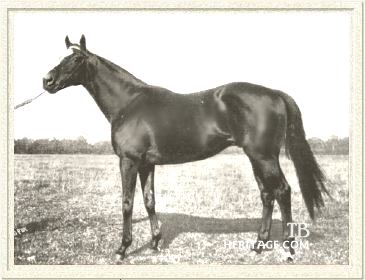 |
|
|
Flying Fox was the last great horse raced by Hugh Lupus Grosvenor, the first Duke of Westminster. The colt was the fourth generation in a remarkable male line developed by the Duke's Eaton Stud near Chester, England. Bend Or was a Derby winner; his son, Ormonde, won the Triple Crown; Ormonde's son, Orme, was a dual Eclipse Stakes winner, and Orme's son, Flying Fox, was to win a second Triple Crown for his breeder.
Flying Fox might not have been conceived, had his dam, Vampire, been a more even-tempered creature. She had been bred by J.G. Hodgson, who sold her to Noel Fenwick. She won only two races, worth £875. Vampire was also a violent-tempered individual. Based on her race record and temperament, she was not an ideal broodmare prospect. But she had pedigree. She was a daughter of Galopin, sire of St. Simon, Galliard, and Donovan, and broodmare sire of Derby winner Ayrshire. The Duke of Westminster was willing to take a chance with her, and purchased her from Fenwick for 1000 guineas.
In her early days at Eaton, the Duke had some instances to repent of his purchase. Richard Chapman, longtime studgroom at Eaton, related to Edward Moorhouse of the Bloodstock Breeders' Review the following account:
|
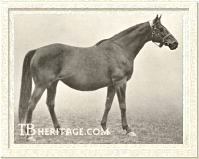
His dam, Vampire
|
|
"The first time he [the Duke] went to look at her in her box after she had reached Eaton, she backed towards him and tried to kick him. This caused his Grace to take a great dislike to her, and he seriously contemplated the idea of at once getting rid of her. Fortunately, however, he finally decided to let her remain. The first season we had her she was put to Gonsalvo. When carrying her foal we sent her to the Kremlin Stud, Newmarket, to be covered by Prince Soltykoff's Sheen. The foal was born in due course, but Vampire, in a fit of temper, killed it and injured the man who was looking after her. After that we never sent her away again when she was in foal or had a foal at foot." |
Many years later, Chapman wasable to send Vampire safely to Welbeck, to be covered by William the Third, the resultant foal being a filly named Mangalmi.
The foal by Sheen was Batt, who lost the Derby by only three quarters of a length to Jeddah, both colts having been foaled in 1895 at Eaton in adjoining stalls. Chapman went on to relate, " We were in a fix when we realized that she was in foal to Sheen, and that it would be unwise to send her away to another stud. The Duke was reluctant to mate her with Orme because the produce would have three close crosses of Galopin. However, he came to the conclusion that there was no other course open to him, so to Orme Vampire was put; and that is how Flying Fox came into being."
Flying Fox was a handsome bay with a broad slash down his face. The Duke's trainer, John Porter, on a visit to Eaton to inspect the youngsters, remarked when he saw Flying Fox, "Here is the winner of the Derby!" The old Duke himself was enamored of the colt, and he quickly became the Duke's favorite. In fact, the normally staid Duke was known to relax his rather stiff facade where Flying Fox was concerned.
Flying Fox on the Turf
Flying Fox was an extremely talented juvenile. The colt was sent to the Duke's longtime trainer, John Porter, who brought him along very carefully. He found Flying Fox to be a highly-strung colt, but he did not have the savage temperament of his dam. Flying Fox started five times, and won three times, and gave plenty of evidence that he was going to be truly exceptional as a classic contender.
Flying Fox made a winning debut in the New Stakes at Ascot, then captured the Stockbridge Foal Stakes. In the Imperial Produce Stakes, the Fox was laden with 136 pounds. He was beaten a mere head by St. Gris, who shouldered 131 pounds. St. Gris was a very highly thought of young horse, as he was by Galopin out of Isabel, making him a half brother to Two Thousand Guineas champion, St. Frusquin, and he went on from this race to win the Richmond Stakes.
Flying Fox also suffered defeat in his next outing, the Middle Park Plate, in which he finished second to the American-bred colt, Caiman. This proved to be the last time any horse ever defeated Flying Fox. He captured his last start at two, the Criterion Stakes, and did so easily under 130 pounds.
The son of Orme and Vampire was put away for the winter, and when he re-emerged , he picked up where he left off the previous autumn, racking up an easy win in the Two Thousand Guineas, with Caiman, his conqueror in the Middle Park Plate, second.
Then came the Derby at Epsom, and one of the most tragic runnings of the race. It was a moderate field, with only the French colt, Holocauste, being given any real chance of upsetting the Duke of Westminster's color bearer. Holocauste had raced in the Prix du Jockey Club only a few days prior to the Epsom Derby. He had lost the French race, but in the English race, partnered by Tod Sloan, he looked like he would indeed lower Flying Fox's colors, before tragedy intervened and the colt shattered his leg. Sloan recollected the events of the race, "Holocauste was going splendidly without urging. I am convinced he had all the steam necessary to win easily, but suddenly I felt him going down...the horse was so game, I think he would have kept on in the race if it had been physically possible. It is impossible to tell how the accident occurred, though the turf was very hard. Of course, there was nothing to do but kill the poor fellow. He lost his life in the gamest race I ever rode."
Flying Fox went on to victory after his rival fell, giving the Duke of Westminster his third Derby winner. The Duke, only months away from his death, took special delight in this win, by his favorite colt, and let out a loud shout of triumph as Flying Fox crossed the wire. This brought strong looks of disapproval from some of the more reserved members of the Jockey Club looking on with the old Duke.
The rest of the season was anticlimactic for Flying Fox. He easily won the Prince of Wales Stakes under 131 pounds, and the Eclipse Stakes at Sandown under 130 pounds. The latter victory enabled the Duke to fulfill a promise to the Royal Alexandra Hospital. He had promised the prize money to the hospital as a charitable donation if his colt won. Flying Fox kept his part of the bargain, and to commemorate the donation, the hospital put up a weathervane adorned by a fox.
|
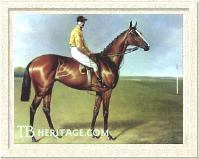
Flying Fox when Racing
| Flying Fox's Race Record |
| Year | Age | Starts | 1st | 2nd | 3rd |
| 1898 | 2 | 5 | 3 | 2 | 0 |
| 1899 | 3 | 6 | 6 | 0 | 0 |
| Total | 11 | 9 | 2 | 0 |
|
|
Flying Fox captured the St. Leger in his next start, and in doing so, became the second Triple Crown winner bred by the Duke. His first had been Flying Fox's grandsire, Ormonde. Flying Fox closed out the season and his career with another easy victory in the Jockey Club Stakes at Newmarket.
Only a couple of months after his win in the Jockey Club Stakes, the Duke of Westminster fell ill and passed away at the age of 75. Most of the Eaton bloodstock was sold at public auction the next year. Among the yearlings sold was a bay filly by Persimmon-Ornament, who went on to undying fame as Sceptre. Flying Fox was also put up for sale. His purchaser was a French breeder, Edmund Blanc, who paid an unheard of 37,500 guineas for Flying Fox, or the equivalent of $190,000, at the time, the largest price ever paid for a horse at auction.
Some of the horses which remained at Eaton included 23-year-old Bend Or, Ornament, the dam of Sceptre, and Flying Fox's parents, Orme and Vampire. This group lived out their days under the ownership of the old Duke's grandson, the second Duke of Westminster, and all are buried in the equine cemetery at Eaton. |
Flying Fox in the Stud
Blanc had every intention of racing Flying Fox as a four-year-old, but when he broached the possibility of Porter continuing to train the colt, Porter refused. Why is unclear. It is speculated that Flying Fox was becoming increasingly difficult to handle as he got older, his mother's temperament gradually surfacing. Whatever the reason, Blanc decided not to enlist another trainer for the colt, and retired him. Flying Fox was then sent to Blanc's stud farm, Haras de Jardy, in France. There, Flying Fox enjoyed considerable success.
|
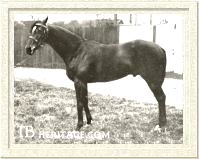
Ajax
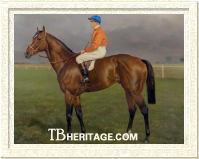
Dagor
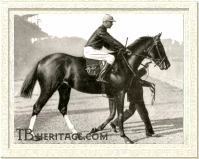
Gouvernant
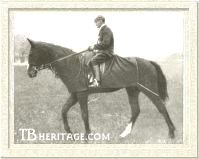
Jardy at Exercise
| |
Flying Fox sired a classic winner in his very first crop. This was AJAX, out of Amie, by Clamart. Ajax, during his turf career, captured the Prix du Jockey Club (French Derby), as well as the Grand Prix de Paris, and then went on to become a highly influential stallion.
Other classic winners sired by Flying Fox included:
FLYING STAR, a winner of the Prix de Diane (French Oaks);
GOUVERNANT, who won the Poule d'Essai des Poulains (French Two Thousand Guineas). Gouvernant was a tough horse, and won many other important races in his career, including the Prix du President de la Republique, the Prix du Cadran, and the Grosser Preis von Baden in Germany. DAGOR won the Prix du Jockey Club and the Poule d'Essai des Poulains. VAL D'OR captured such events as the Grand Criterium and the Poule d'Essai des Poulains. Sent to England, he took the measure of Derby winner Cicero by beating him in the Eclipse Stakes. Val D'Or was sent to Argentina for stud duty, and was fairly successful, his best offspring being the filly Ocurrencia, who was victorious in such events as the Gran Premio Jockey-Club, Polla de Potrancas, and the Gran Premio Seleccion. She also dead-heated in the Gran Premio Carlos Pellegrini.
Flying Fox also came up with ADAM, a winner of the Prix Eclipse and the Prix de la Foret; JARDY, foaled from the Oaks victress Airs and Graces, by Ayrshire, captured the Criterium International and the Prix Noailles and was later a successful sire in Argentina. FILS DU VENT won the premier juvenile race, the Omnium. Flying Fox's daughter, QUEEN OF THE EARTH, out of Lonely, by Hermit, placed second to Cherry Lass in the 1905 Epsom Oaks. ADAM, GOUVERNANTE and DAGOR all went to Austria-Hungary as stallions, where they had some impact in the stud, at least until the disaster of World War II.
Some of Flying Fox's grandsons also bred on. Adam sired Marsa, a winner of the Prix de Diane. But perhaps the most significant grandson of Flying Fox was Teddy, from the first crop of Ajax and out of the Bay Ronald mare, Rondeau.
Teddy was sold for a small price during World War I to Jefferson Davis Cohn, and sent to race in Spain, where he became the champion three-year-old of 1916. Teddy served stud duty in France after the war, and eventually was sold by Cohn to American interests and then imported in his old age to stand the remainder of his life at Kentmere Stud in Virginia.
Teddy's offspring kept Flying Fox prominent in pedigrees. Full brothers Sir Gallahad III and Bull Dog, both out of Plucky Liege, by Spearmint, each were brought to the United States where they were successful sires. Teddy's American sons, Sun Teddy, tail-male progenitor of Damascus, and Case Aces, broodmare sire of Raise a Native, both exerted considerable influence in modern pedigrees. Teddy's daughter, La Troienne, is widely regarded as one of the most influential broodmares in the history of modern Thoroughbred breeding, with nearly a thousand stakes winners descending from her in the female line.
|
Flying Fox died at Haras de Jardy on March 21, 1911 at the age of fifteen. Surprisingly, with all the success he enjoyed at stud, he was champion sire in France only once, posthumously, in 1914. But his line, which continued through his son, Ajax, has secured Flying Fox's important place in breeding history.
--by Elizabeth Martiniak
|
|
|
|

